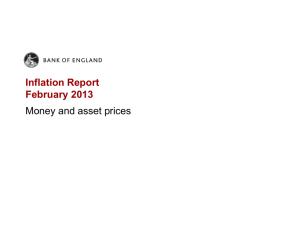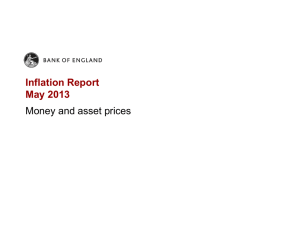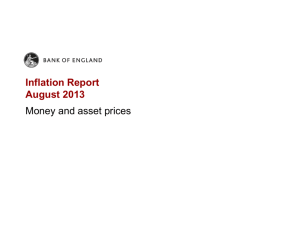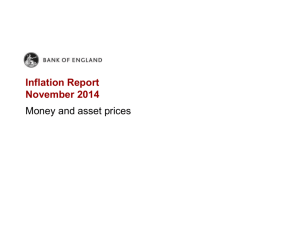Inflation Report November 2012 Money and asset prices
advertisement
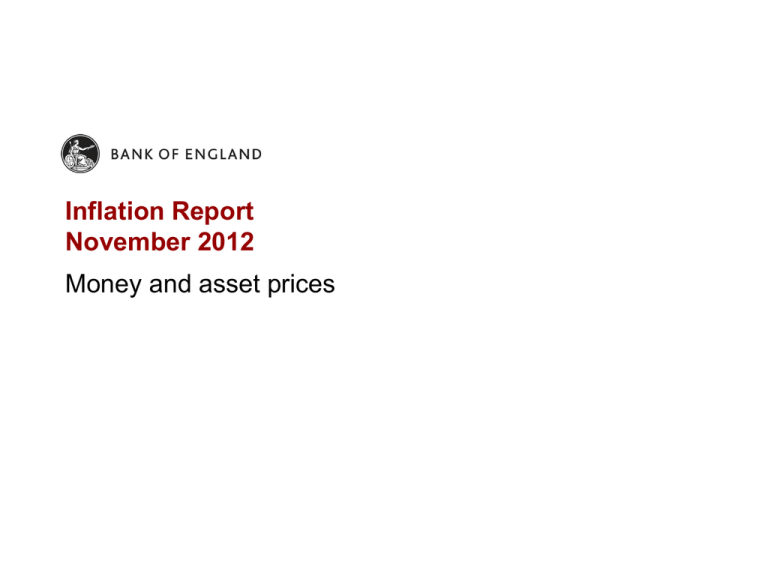
Inflation Report November 2012 Money and asset prices Chart 1.1 Bank Rate and forward market interest rates(a) Sources: Bank of England and Bloomberg. (a) The August 2012 and November 2012 curves are estimated using overnight index swap rates in the fifteen working days to 1 August 2012 and 7 November 2012 respectively. Chart 1.2 Selected international official interest rates and forward market interest rates(a) Sources: Bank of England, Bloomberg, European Central Bank and Federal Reserve. (a) (b) (c) (d) Forward market interest rates are estimated using overnight index swap rates in the fifteen working days to 7 November. Bank Rate. Target federal funds rate. Since 16 December 2008 the target rate has been set as a range of 0% to 0.25%. The data show the upper bound of that range. ECB deposit facility rate. Chart 1.3 Italian and Spanish two-year government bond yields and five-year yields, five years forward Sources: Bank of America/Merrill Lynch and Bloomberg. (a) Derived from government liability curves. (b) Yields to maturity. Chart 1.4 UK ten-year nominal spot gilt yields and selected forward rates(a) Sources: Bloomberg and Bank calculations. (a) Zero-coupon yield. (b) Derived from the Bank’s government liability curves. Chart 1.5 International equity prices(a) Source: Thomson Reuters Datastream. (a) In local currency terms. Chart 1.6 Non-financial companies’ sterling investment-grade corporate bond spread and yield(a) Source: Bank of America/Merrill Lynch. (a) Excludes utility companies. (b) Option-adjusted spread over equivalent-maturity government bonds. Chart 1.7 Cumulative net corporate bond issuance by private non-financial corporations over calendar years(a) (a) Monthly net issuance of sterling and foreign currency stand-alone and programme bonds. Data are non seasonally adjusted. Chart 1.8 Sterling exchange rates Chart 1.9 UK banks’ indicative longer-term funding spreads Sources: Bank of England, Bloomberg, Markit Group Limited and Bank calculations. (a) The data show a simple average of the five-year CDS premia of Barclays, HSBC, Lloyds Banking Group, Nationwide, Royal Bank of Scotland and Santander UK. (b) Sterling only. Spread over the three-year swap rate. The three-year retail bond rate is a weighted average of rates from banks and building societies within the Bank of England’s normal quoted rate sample with products meeting the specific criteria (see www.bankofengland.co.uk/statistics/Pages/iadb/notesiadb/household_int.aspx). (c) The data show a simple average of the spread between euro-denominated senior unsecured bonds and equivalent-maturity swap rates for a selected bond issued by each of the major UK lenders. The selected bonds have residual maturities of between two and six years. (d) The data show a simple average of the spread between euro-denominated covered bonds and equivalent-maturity swap rates for a selected bond issued by each of the major UK lenders. The selected bonds have residual maturities of between three and seven years. Chart 1.10 Credit Conditions Survey: changes in credit availability(a) (a) Weighted responses of lenders. A positive balance indicates an increase in credit availability and a negative balance indicates credit availability had fallen in that quarter. (b) Expectations over the next three months are shown for the 2012 Q2 and Q3 surveys only. Expectations balances have been moved forward by one quarter so that they can be compared with the actual outturns in the following quarter. Chart 1.11 Bank Rate and average quoted mortgage interest rates(a) (a) Sterling-only end-month average quoted rates. The Bank’s quoted interest rates series are weighted averages of rates from a sample of banks and building societies with products meeting the specific criteria (see www.bankofengland.co.uk/statistics/Pages/iadb/notesiadb/household_int.aspx). (b) Two-year fixed-rate mortgage. (c) Series has not been published since April 2008 as fewer than three products have been offered in that period. (d) Series is only available on a consistent basis back to May 2008, and is not published for March to May 2009 as fewer than three products were offered in that period. Chart 1.12 Loans to PNFCs and households (a) M4 loans excluding the effects of securitisations and loan transfers. (b) Sterling lending by UK-resident monetary financial institutions (MFIs) and related specialist mortgage lenders excluding the effects of securitisations and loan transfers. Funding for Lending Scheme measure. Non seasonally adjusted. (c) Sterling lending by UK-resident MFIs and other lenders. Excludes student loans. Chart 1.13 Sectoral broad money(a) (a) Monthly data unless otherwise specified. (b) Quarterly data. Intermediate other financial corporations (OFCs) are: mortgage and housing credit corporations; non-bank credit grantors; bank holding companies; securitisation special purpose vehicles; and other activities auxiliary to financial intermediation. In addition to the deposits of these five types of OFCs, sterling deposits arising from transactions between banks or building societies and ‘other financial intermediaries’ belonging to the same financial group are excluded from this measure of broad money. Tables Table 1.A Credit Conditions Survey: spreads on household and corporate loans(a) (a) (b) (c) (d) Weighted responses of lenders. A positive balance indicates that spreads over reference rates had risen and a negative balance indicates spreads had fallen in that quarter. Data in parentheses show lenders’ expectations for the following three months reported in the 2012 Q2 survey. Data in parentheses show lenders’ expectations for the following three months reported in the 2012 Q3 survey. Data are only available from 2009 Q4. Table 1.B Housing market indicators Sources: Bank of England, Halifax, HM Revenue and Customs, Land Registry, Nationwide, ONS, Royal Institution of Chartered Surveyors (RICS) and Bank calculations. (a) (b) (c) (d) (e) (f) (g) (h) Averages of monthly data. Except for property transactions, which is an average since April 2005. Number of residential property transactions with value £40,000 or above. Loan approvals for house purchase. Ratio of sales recorded over the past three months to the level of stock on estate agents’ books at the end of the month. Percentage changes. 2012 Q3 estimate is an average of data for July and August. Data relate to England and Wales only. A framework for how the Bank will monitor the transmission of the Funding for Lending Scheme Figure 1 Stylised FLS transmission and selected indicators(a) (a) The listed indicators are a selection of the full range of indicators at each stage. In broad terms, initial indicators of Stage 1 and Stage 2 are already available; those at Stages 3 and 4 will become available in coming months. As the typical lag between a mortgage approval and transaction is two to four months, the FLS is unlikely to begin to affect household lending until early 2013. It is probable, however, that it will take longer for the FLS to affect corporate lending.
